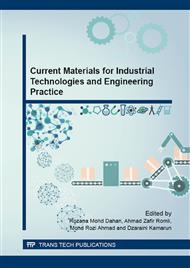[1]
R. Khandkar-Siddikur, D.M. Nazmul Alam and I. Md. Nazrul, Some physical and mechanical properties of bamboo mat-wood veneer plywood. ISCA Journal of Biological Science. Vol. 1(2), (2012), 61-64.
Google Scholar
[2]
I. Aydm, S. Colak, G. Colakoglu and E. Salih, A comparative study on some physical and mechanical properties of laminated veneer lumber (LVL) produced from beech (fagus orientalis lipsky) and eucalyptus (eucalyptus camaldulensis dehn) veneers. Holz Roh Werkst (2004).
DOI: 10.1007/s00107-004-0464-3
Google Scholar
[3]
L. Xiaobo, Physical, Mechanical and Chemical Properties of Bamboo and its Utilization Potential for Fibreboard Manufacturing. Thesis Degree of Master of Science Lousiana State University, (2004).
Google Scholar
[4]
M.I. Sulastiningsih, and Nurwati, Physical and mechanical properties of laminated bamboo board. Journal of Tropical Forest Science, Vol. 21(3) (2009), 246-251.
Google Scholar
[5]
International Workshop on Advanced Bamboo Utilization and its Strategy. FORTROP. Faculty of Forestry, Kasertsart University Thailand.
Google Scholar
[6]
W. Razak, W.S. Hashim and H.M. Azmy, Properties of boars from 3 layers laminated and composites-ply from tropical bamboo Giantochloa scortechinii. Borneo Science 12 (2002) 43-50.
Google Scholar
[7]
K. Jamaludin, A.H. Abdul Jalil, H. Jalaludin, A. Zaidon, M. Abbd. Latif, and Y.M. Mohd Nor, Properties of particleboard manufactured from commonly utilized Malaysian bamboo (Gigantochloa scortechinii). Journal Tropical Agriculture Science, Vol. 24(2) (2001).
DOI: 10.1163/156915902760181586
Google Scholar
[8]
C.H. Mohd Aminuddin, M. Suhaimi and S. Abd Hamid, Strength performance and dimensional stability of peeled bamboo-fibreglass composite (PBFC) from buluh betong. Journal of Tropical Resource and Sustainable Science 2 (2014), 16-22.
DOI: 10.47253/jtrss.v2i1.488
Google Scholar
[9]
K. Ramazan, and C. Muhammet, Effect of press pressure on glue line thickness and properties of laminated veneer lumber glued with melamine urea formaldehyde adhesive. BioResources, Vol. 7(3) (2012), 4341-4349.
DOI: 10.15376/biores.7.3.4341-4349
Google Scholar
[10]
K. Ramazan, and C. Muhammet, Effect of press pressure on glue line thickness and properties of laminated veneer lumber glued with phenol formaldehyde adhesive. BioResources, Vol. 7(4) (2012), 5346-5354.
DOI: 10.15376/biores.7.4.5346-5354
Google Scholar
[11]
M. Mohd Hafiz. Mechanical and physical properties of hybrid oil palm-rubberwood engineered veneer lumber (HOPREV) for furniture components. Thesis master in science UiTM Selangor, Malaysia (2011).
Google Scholar
[12]
K. Pavel, K. Pert, K. M. Pawan, R. Peter, and W. Rupert, Preparation and characterization of cork layered compasite plywood boards. BioResources Vol. 9 (2) (2014), 1977-(1985).
Google Scholar
[13]
Z. E. Yusuf, Z. Jilei, and A. E. Carl, Holding strength of screws in plywood and orientated strandboard. Forest Products Journal, Vol. 52, No. 6 (2002), 55-62.
Google Scholar


